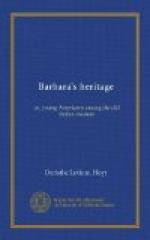Barbara was so carried away by the picture that she had forgotten herself entirely, and spoke with her old-time frank eagerness, thereby thoroughly delighting Bettina and Mr. Sumner.
“I am glad you feel so,” said the latter, very quietly, and with a strictly impersonal manner. “Francia, who belonged to the old Bolognese masters of the sixteenth century, was one of the most devout of painters, and everybody who studies his work must love it. See how pure and sweet are his expressions! How simple his composition! What harmony is in his coloring! How beyond those who painted after him!”
[Illustration: RAPHAEL. ACADEMY, BOLOGNA.
SAINT CECILIA.]
They tarried long before Francia’s paintings and the St. Cecilia. Mr. Sumner told them to note the more subtle motif of Raphael’s picture; the superior grace of the figures, their careful distribution, and the fine scheme of color; the sympathetic look in St. John’s face; the grandly meditative St. Paul.
“I have a theory of my own about the meaning of this picture,” said Bettina. “I thought it out one day when I was studying the photograph. I know it is always said, in descriptions of it, that all are listening to the music of the angels, but I do not think any of them save St. Cecilia hear the music of the angelic choir. She hears it, because she has so longed for it,—so striven to produce the highest music on earth. But the others are only moved by their sympathy with her. See the wistful look on St. John’s face, and St. Augustine’s also. And St. Paul is lost in wondering thought at St. Cecilia’s emotion. And Mary Magdalene is asking us to look at her and try to understand her rapt upward look.”
“I do not know,” said Mr. Sumner, with a soft look in his eyes, “why you should not have your own private interpretation of the picture, dear ’Lady Betty’;” and he smiled at Malcom as he used the latter’s favorite appellation for Bettina.
Chapter XVIII.
In Venice.
From
the land we went
As to a floating city—steering
in,
And gliding up her streets
as in a dream
By many a pile in more than
eastern pride,
Of old the residence of merchant-kings:
The fronts of some, tho’
time had shattered them,
Still gleaming with the richest
hues of art,
As though the wealth within
them had run o’er.
—ROGERS.
[Illustration: SAN MARCO, VENICE.]
Just after sunset the following evening they approached Venice. The long black train glided along above a sea flushed with purple and crimson and gold. Like a mirage the fair city—Longfellow’s “white water-lily, cradled and caressed”—arose, lifting her spires—those “filaments of gold”—above the waters.
“Can it be real?” murmured Bettina. “It seems as if all must fade away before we reach it.”




